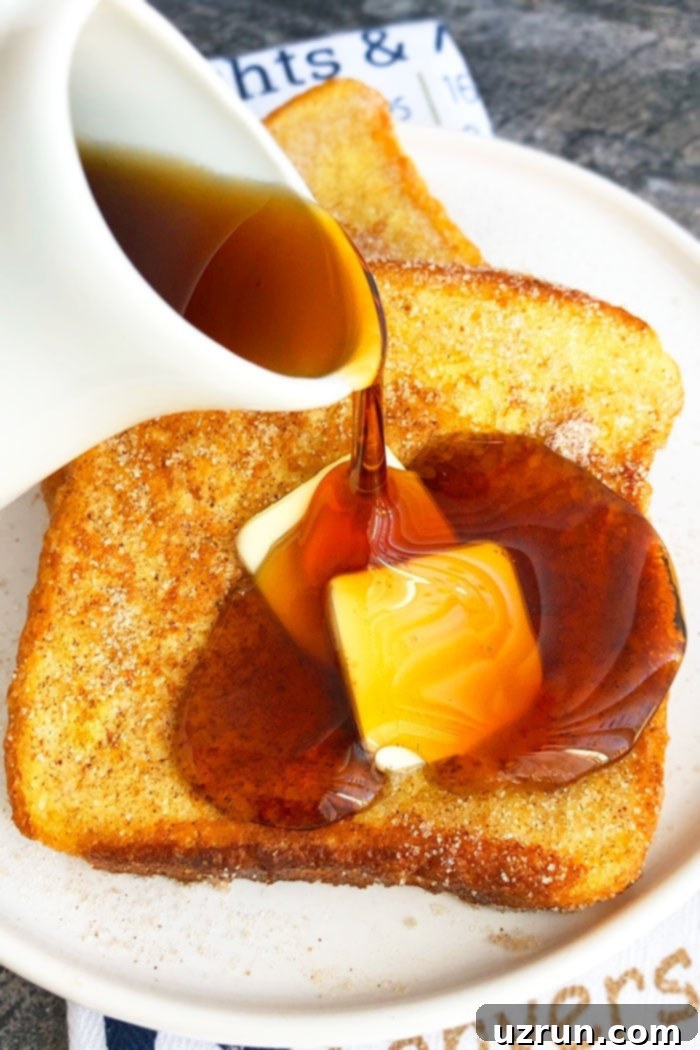Best Homemade Cinnamon French Toast Recipe: Quick, Easy & Fluffy
Welcome to the ultimate guide for making the best homemade cinnamon French toast. This classic recipe is not just quick and easy, requiring only simple ingredients, but it also delivers a sweet, soft, and fluffy breakfast or brunch delight in under 20 minutes. Often lovingly referred to as “churro French toast” due to its delightful cinnamon-sugar coating, this dish is guaranteed to become a family favorite.
If you’ve enjoyed our other popular recipes like Cinnamon French Toast Sticks or our seasonal Eggnog French Toast, then prepare to fall in love with today’s offering. Its irresistible fluffy texture, sweet flavor, and warm spiced aroma make it an ideal choice for any morning meal or a leisurely weekend brunch. Just a quick note: this is distinctly different from “eggy bread,” which is typically a savory dish.
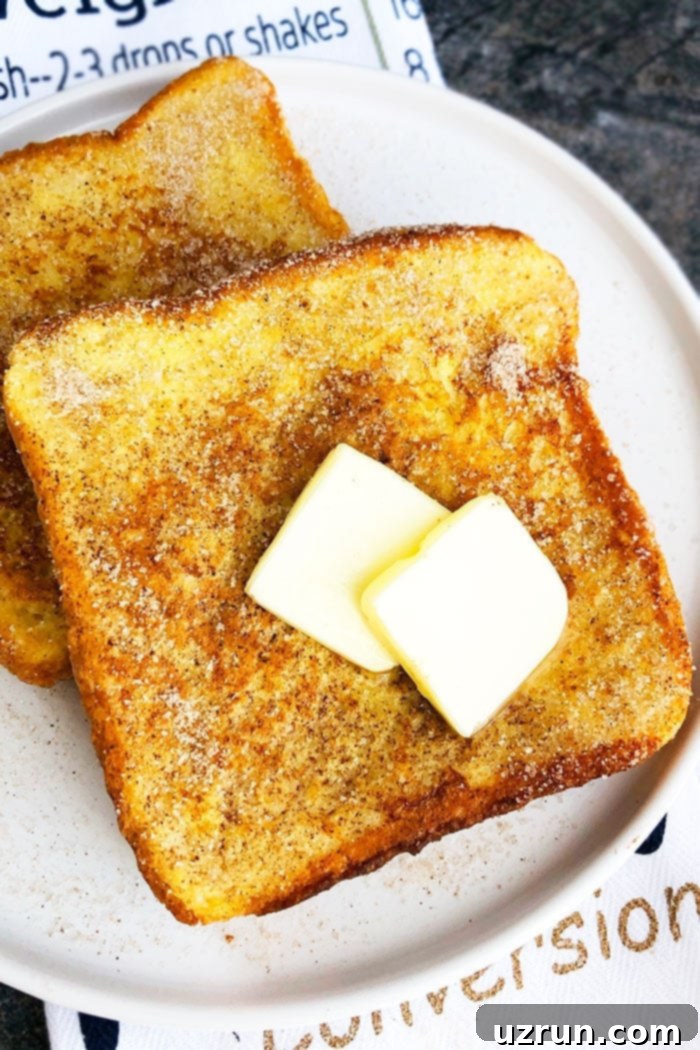
How to Make the Best Cinnamon French Toast from Scratch
Creating this delicious homemade French toast is surprisingly simple. With just a few basic steps, you’ll have a mouthwatering breakfast on your table in no time. Follow these easy instructions for perfectly cooked, golden-brown slices.
- Prepare the Batter: In a wide, shallow bowl, combine eggs, milk, brown sugar, and vanilla extract. Whisk thoroughly until all ingredients are well incorporated and smooth. This is the foundation of your fluffy French toast.
- Dip the Bread Slices: Gently dip each slice of bread into the egg mixture. It’s crucial not to soak the bread for too long, especially if using fresh bread, as this can lead to soggy French toast. A quick dip on each side is usually sufficient.
- Pan-Fry to Golden Perfection: Lightly shake off any excess liquid from the dipped bread. Place the slices onto a preheated, buttered nonstick pan or griddle. Cook each side for 2-3 minutes, or until it achieves a beautiful golden-brown color and the center is cooked through.
- Add Cinnamon Sugar Coating (Optional but Recommended!): While the French toast is still warm, mix granulated sugar and cinnamon powder in a separate shallow dish. Coat the warm bread slices in this aromatic mixture, ensuring they are fully covered for that “churro French toast” experience.
- Serve and Enjoy: Transfer your freshly cooked cinnamon French toast to plates. Add your favorite toppings (we have plenty of ideas below!) and dig into this sweet, soft, and fluffy treat!
What to Serve with Homemade French Toast: Delicious Toppings & Fillings
While classic maple syrup and butter are always a hit, French toast is incredibly versatile and pairs beautifully with a wide array of toppings and stuffings. Get creative with these ideas to elevate your breakfast or brunch experience:
- Sweet & Simple Dustings: A light sprinkle of powdered sugar for elegance, or our optional cinnamon sugar coating for an extra layer of warmth.
- Creamy Delights: Fluffy homemade whipped cream, a scoop of your favorite ice cream, or a dollop of flavored yogurt.
- Rich & Indulgent Sauces: A luscious melted chocolate drizzle, decadent dulce de leche, smooth warm peanut butter, or silky caramel sauce. Don’t forget warm Nutella syrup for chocolate-hazelnut lovers.
- Fresh & Fruity Additions: A colorful assortment of fresh fruits like sliced apples, bananas, strawberries, blueberries, or peaches. These add a refreshing contrast to the sweet toast.
- Crunchy Textures: A handful of chopped nuts (walnuts, pecans, almonds) for a satisfying crunch, or even mini chocolate chips for an extra touch of sweetness.
- Decadent Spreads & Jams: A variety of jams and jellies such as raspberry, grape, blueberry, apricot, or even zesty orange marmalade.
- Warm Fruit Fillings: Transform your French toast into a dessert-like experience with warm pie fillings. Try blueberry pie filling, cherry pie filling, raspberry pie filling, or peach pie filling.
- Classic Syrups: Of course, don’t forget the staples: rich maple syrup, golden honey, or a lighter agave syrup.
- Unique & Savory Twists (with sweet notes): For something different, consider a drizzle of easy chocolate gravy, comforting Crockpot pumpkin butter, or spiced Crockpot apple butter.
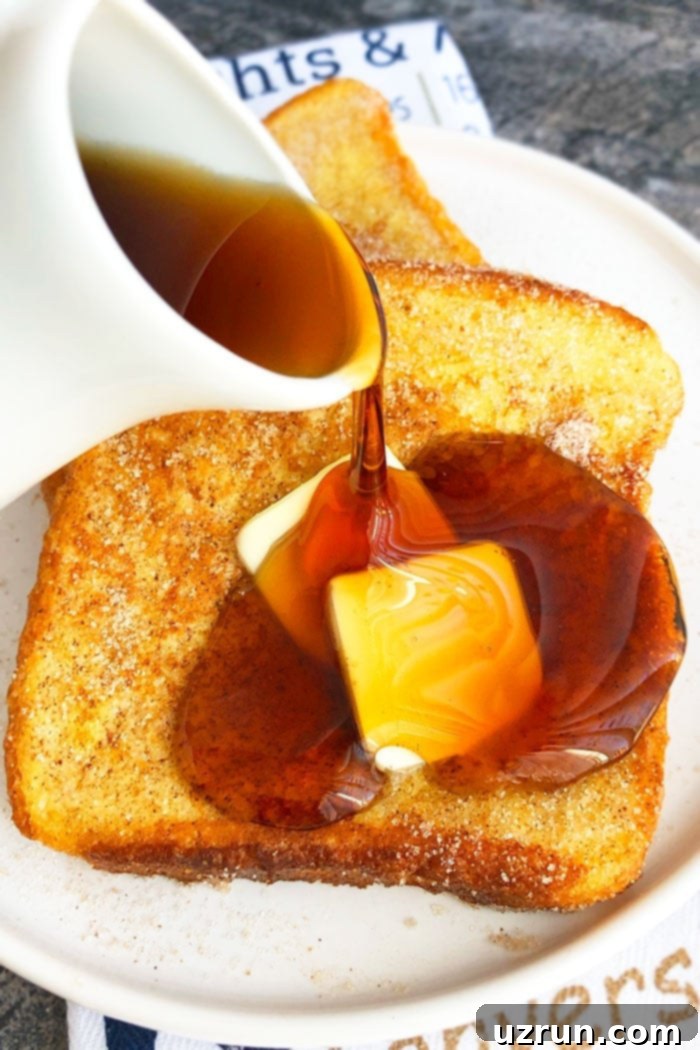
What is the Best Bread for French Toast (and Why)?
The type of bread you choose can significantly impact the final texture and flavor of your French toast. For the absolute best results, we recommend using a thick, soft, and slightly stale bread loaf. This allows the bread to absorb the custardy batter without becoming overly soggy.
Here are some top choices:
- Texas Toast: Its extra thickness is perfect for soaking up the batter while retaining its structure, resulting in a delightfully fluffy interior.
- Challah: This rich, egg-based bread has a slightly sweet flavor and a dense, tender crumb, making it ideal for a luxurious French toast.
- Brioche: Another egg-rich bread, brioche is incredibly buttery and tender. It toasts beautifully, creating a wonderfully soft and flavorful French toast.
- Day-Old White Bread: If you don’t have the above, a good quality, day-old loaf of thick white bread works very well. Stale bread is key as fresh bread can absorb too much liquid and become limp.
While you can use other types of bread like whole wheat, hardy grain, pumpernickel, sourdough, or rye, be aware that their distinct flavors and firmer crusts might alter the final product. Breads with a harder crust will yield a crunchier result, which some people enjoy, but it might not be the classic soft and fluffy texture you’re aiming for. Ultimately, the best bread is often what you have on hand, but for optimal results, prioritize thick, soft, and slightly stale options.
French Toast Ingredients and Batter Essentials
The magic of French toast lies in its simple yet effective batter. The basic ingredients come together to create a rich, custardy mixture that transforms ordinary bread into an extraordinary treat.
Typically, a classic French toast batter is made by combining:
- Eggs: The binding agent that gives French toast its custardy texture and golden color.
- Milk: Adds richness and helps thin out the batter. Whole milk is recommended for the best flavor and creaminess, but any milk will do.
- Vanilla Extract: A crucial flavor enhancer that adds warmth and sweetness.
- Sugar: Sweetens the batter directly, complementing the other ingredients. Brown sugar is used in this recipe for a deeper, caramelized note.
- Bread: The star of the show! As discussed, thick, slightly stale bread is best.
- Butter: Essential for pan-frying, adding flavor and ensuring a perfectly golden, slightly crispy exterior.
Beyond these core ingredients, you can easily customize your batter. Many people love adding a dash of cinnamon or nutmeg for a spiced flavor, or other extracts like almond or maple for a different twist. Replacing milk with heavy cream will result in an even richer, more decadent French toast.
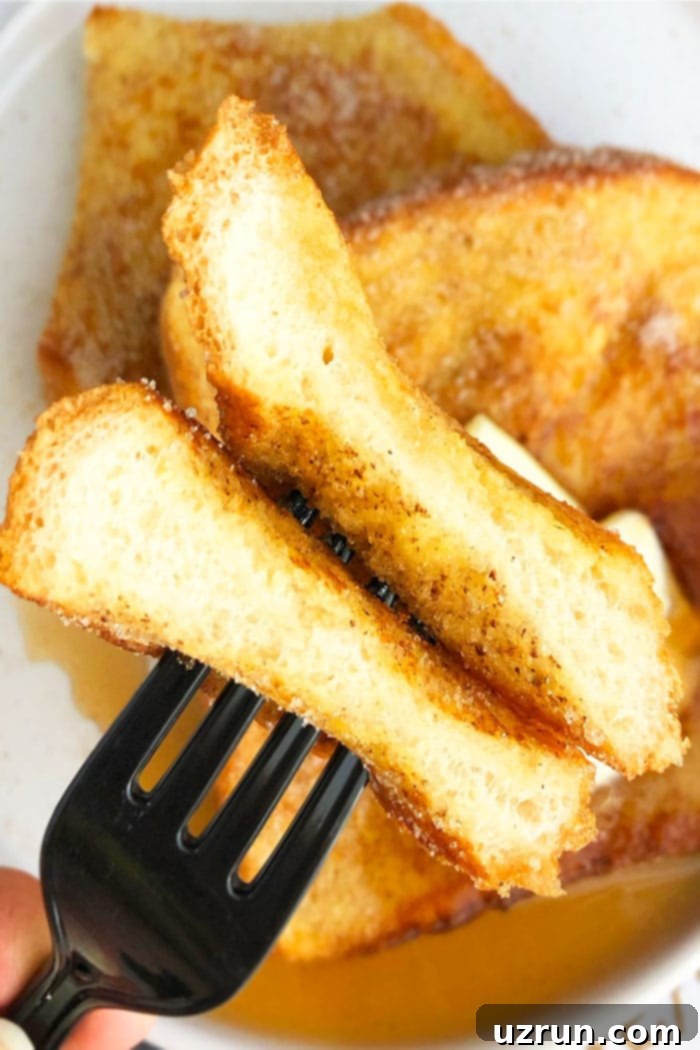
Creative French Toast Variations to Try
This classic cinnamon French toast recipe serves as an excellent base for numerous creative variations. Don’t be afraid to experiment and make it your own!
- French Toast Roll-Ups: For a fun, bite-sized treat, cut the crust off each bread slice and roll them flat with a rolling pin. Spread your favorite filling on one side – think jams, fruit preserves, Nutella, fresh fruit slices, or even chocolate chips. Roll them up tightly, dip in the egg batter, and pan-fry until golden brown. Serve with a dusting of powdered sugar!
- Stuffed French Toast: Elevate your French toast by stuffing it! My absolute favorite version is s’mores stuffed French toast. Place chocolate chips and mini marshmallows between two slices of bread, then dip and cook until the outside is golden and the filling is ooey-gooey and perfectly melted. Other delicious fillings include cream cheese, berries, or even thinly sliced cooked apples.
- Experiment with Different Breads: While thick white bread (like Texas Toast) is a fantastic choice, feel free to use brioche or challah for a richer flavor profile, or even try a gluten-free bread for those with dietary restrictions. The key is to ensure the bread is thick enough to hold up to dipping.
- Add Other Flavorings to the Batter: Enhance the batter with different extracts such as almond, lemon, or peppermint for a festive touch. You can also add citrus zests like orange or lemon for a brighter flavor. A pinch of nutmeg or cardamom can also add depth to the cinnamon.
Storage and Reheating Tips for French Toast
While French toast is always best served fresh off the pan, sometimes you might have leftovers or want to prep ahead. Here’s how to store and reheat your cinnamon French toast:
- Refrigerate Leftovers: Cooked French toast can be stored in an airtight container in the refrigerator for 1-2 days. While they won’t be as crisp as when freshly made, they will still be delicious.
- Freezing (Not Personally Recommended, But Possible): I personally don’t recommend freezing French toast as the texture often changes upon thawing, becoming a bit softer. However, many people successfully freeze them in sealed freezer bags for up to 1 month. If you plan to freeze, do not add the cinnamon-sugar coating until reheating, as it can become sticky.
- Reheat for Best Results:
- Microwave: Quickest option, but can make French toast a bit soft. Heat in 30-60 second intervals until warm.
- Stovetop: For a slightly crispy exterior, reheat in a lightly buttered pan over medium heat until warmed through and golden.
- Toaster Oven: A great option for restoring some crispness. Heat at 350°F (175°C) for 5-10 minutes, or until heated through and lightly toasted.
Expert Tips for Perfect Cinnamon French Toast Every Time
Achieving consistently perfect French toast is easy with these tried-and-true tips and techniques:
- Avoid Soggy French Toast: The most common culprit for soggy French toast is over-soaking the bread in the egg mixture. A quick dip, just enough for the bread to absorb some liquid but not become saturated, is key. Also, ensure your batter has the right egg-to-milk ratio; too much milk can make it runny. Measure your ingredients carefully!
- Use Stale Bread: This is a golden rule for French toast. Fresh bread is too soft and will absorb too much of the egg custard, leading to a limp and soggy result. Day-old bread (or even slightly toasted fresh bread) holds its shape better and absorbs the batter more evenly.
- Crust On or Off?: This is entirely a matter of personal preference. You can keep the crust for a slightly firmer edge and less waste, or remove it for a uniformly soft texture, especially if making roll-ups or for picky eaters.
- Make Ahead Prep: To save time on busy mornings, prepare the egg mixture and cinnamon sugar blend a day in advance and store them in the refrigerator. You can also pre-slice your bread. This way, all the prep work is done, and you can start cooking immediately.
- Coat in Cinnamon Sugar While Warm: If you’re opting for the cinnamon sugar coating, make sure to do it as soon as the French toast comes off the pan. The warmth helps the sugar mixture adhere properly; if the toast cools down, the sugar won’t stick.
- Choose Unsalted Butter for Frying: Using unsalted butter in the pan gives you control over the overall saltiness of your dish. Since you’re adding sugar and potentially other sweet toppings, you don’t want the French toast to become too salty.
- Don’t Overheat the Pan: Cooking French toast requires medium heat. If the pan is too hot, the exterior will burn quickly while the inside remains undercooked and soggy. A moderately hot pan ensures even cooking and a beautiful golden-brown finish on both sides.
More Easy Breakfast Recipes to Explore
If you’re looking for more delicious ways to start your day, check out these other easy and delightful breakfast recipes from our kitchen:
- Baked Apple Cider Donuts
- Apple Fritters
- Chocolate Waffles
- Homemade Cinnamon Rolls
Easy Cinnamon French Toast Recipe
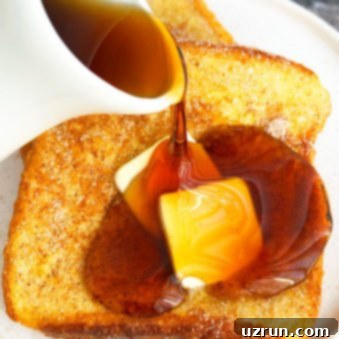
Easy French Toast
By Abeer Rizvi
The best, classic, quick and easy cinnamon French toast recipe, homemade with simple ingredients in 20 minutes. Sweet, soft and fluffy!
Rating: 5 out of 5 stars (based on 1 rating)
Pin Recipe
Prep Time: 5 mins
Cook Time: 15 mins
Total Time: 20 mins
Course: Breakfast
Cuisine: American, French
Servings: 8 French toast slices
Calories: 298 kcal
Ingredients
- 4 Large Eggs
- 4 tablespoon Whole milk (or heavy cream)
- 1 teaspoon Vanilla extract
- 1.5 tablespoon Brown sugar
- 8 slices Thick bread (such as Texas toast, Brioche, or Challah, preferably stale)
- Unsalted Butter (for pan-frying)
Cinnamon sugar (Optional)
- 1 cup Granulated sugar
- 1.5 tablespoon Cinnamon powder
Instructions
- In a wide mixing bowl, combine eggs, milk, vanilla extract, and brown sugar. Whisk until thoroughly combined and smooth.
- Quickly dip each bread slice into the egg mixture. Do not soak them; a swift dip on both sides is enough to coat without making them soggy.
- Shake off any excess liquid and place the coated bread slices onto a hot, buttered nonstick pan or griddle.
- Cook one side until it’s golden brown (about 2-3 minutes), then flip and cook the other side until also golden brown and cooked through.
- Optional Cinnamon Sugar Coating: In a separate shallow dish, mix granulated sugar and cinnamon powder. Immediately after cooking, coat the warm French toast slices in this mixture until fully covered.
- Serve immediately, topped with thin slices of butter and a generous drizzle of maple syrup or your preferred pancake syrup. Enjoy!
Notes
- Refer to the “Expert Tips for Perfect Cinnamon French Toast Every Time” section above for detailed advice and techniques.
- This French toast tastes best when served fresh. However, leftovers can be stored in a sealed container in the fridge for up to 24 hours and reheated on the stovetop or in the microwave. Note that they may lose some crispness upon reheating.
Nutrition
Calories: 298kcal | Carbohydrates: 54g | Protein: 8g | Fat: 5g | Saturated Fat: 1g | Cholesterol: 109mg | Sodium: 236mg | Potassium: 107mg | Fiber: 1g | Sugar: 28g | Vitamin A: 245IU | Calcium: 87mg | Iron: 2.1mg
Please note: Nutritional information is calculated using an automated tool and cannot be guaranteed for accuracy.
Frequently Asked Questions About Cinnamon French Toast
- Can I use frozen bread for French toast?
- Yes, you can use frozen bread! Simply thaw it completely first. In fact, slightly stale or even defrosted bread is often preferred for French toast because it absorbs the batter better without becoming soggy, compared to very fresh bread.
- What’s the difference between French toast and ‘eggy bread’?
- While both involve bread dipped in egg, “eggy bread” is typically a savory dish, often seasoned with salt and pepper, and sometimes served with ketchup or savory toppings. French toast, especially this cinnamon variety, is inherently sweet, flavored with sugar and vanilla, and often served with sweet toppings like syrup or fruit.
- Can I make French toast without milk?
- You can substitute milk with other liquids if needed. Cream, half-and-half, or even a non-dairy milk alternative like almond milk or soy milk can work. The fat content might affect the richness, but the basic principle remains the same.
- How do I prevent French toast from sticking to the pan?
- Ensure your pan is properly preheated and generously buttered (or oiled). Using a good quality nonstick pan also helps immensely. Don’t flip the toast too early; let it cook until it naturally releases from the pan when gently nudged.
- Can I make the batter ahead of time?
- Absolutely! The French toast batter can be made a day in advance. Whisk all ingredients together, cover, and refrigerate. Give it a quick whisk again before dipping your bread slices. This makes breakfast prep even quicker!
Until next time, tata my lovelies! Enjoy your delightful homemade cinnamon French toast.
